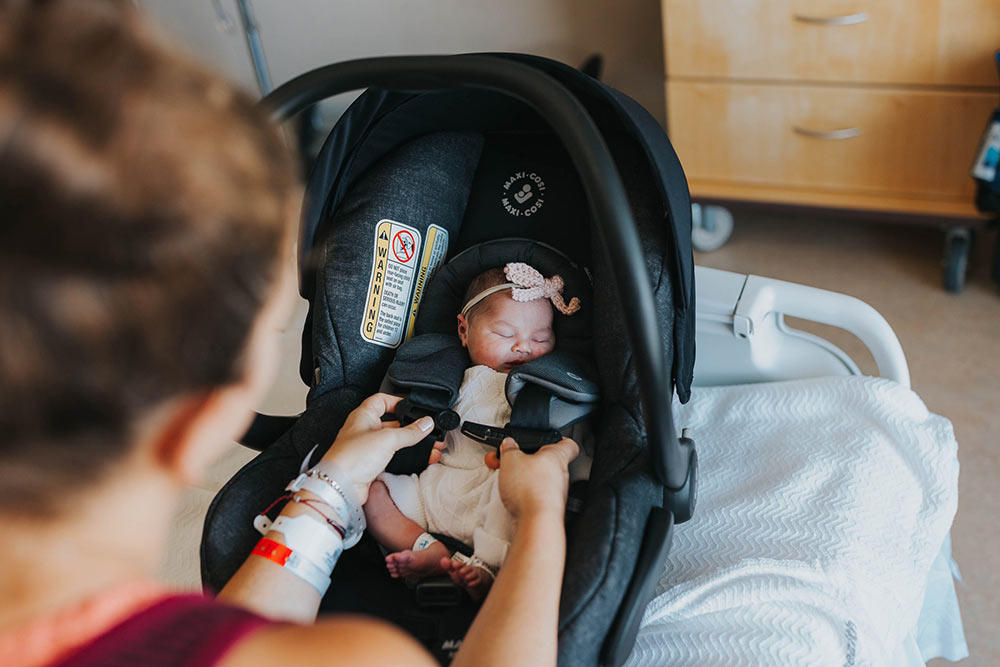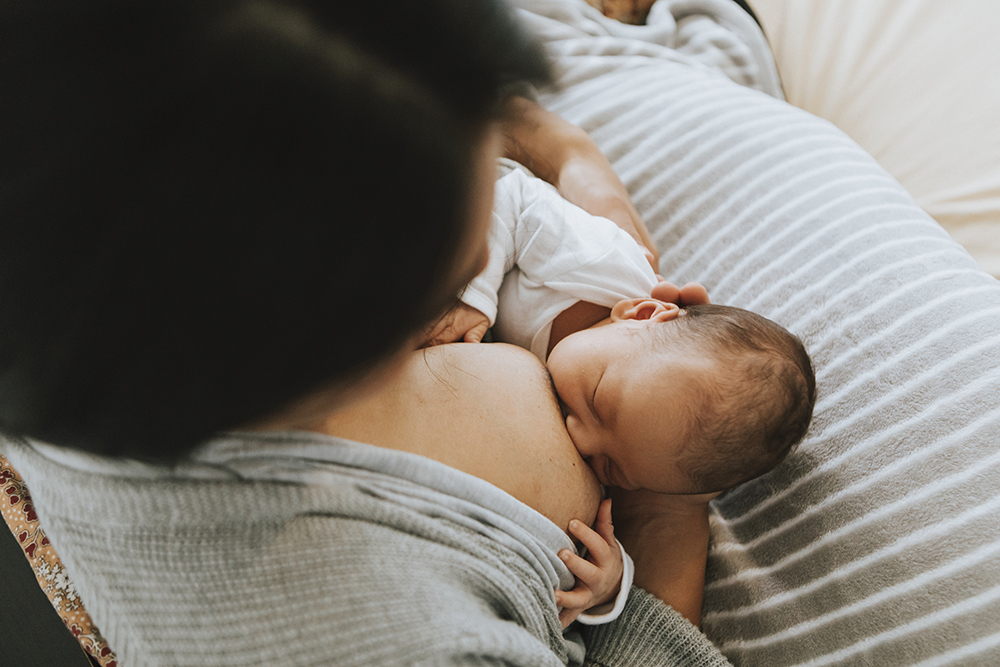A Postpartum Recovery Timeline

After nine months of uncontrollable emotions, massive body changes and strange pregnancy symptoms, you might be looking forward to things returning to normal when baby arrives. However, the postpartum recovery period can be as draining as the gestation period. Prepare for what’s to come with our postpartum recovery timeline.
Week 1
Physically: Congratulations—you did it! As soon as your bundle makes his entrance, all that effort you put in to get him here will be more than worth it.
“Bonding starts right when the baby is placed on mom’s chest in the delivery room,” shares Jeffrey Brown, MD, a MEDNAX National Medical Group pediatric hospitalist in Denver. Skin-to-skin contact can help regulate a newborn’s body temperature and heart rate, secure lasting breastfeeding success, and comfort your infant after a rather stressful ordeal. (Squeezing through the birth canal isn’t easy!) Take these first moments with your newbie to soak in his awesomeness.
As the excitement settles down, you’ll begin to take stock of your physical state. Things won’t be pretty for the first 24 hours. Your stomach will not yet be significantly smaller—you’ll leave the hospital looking about six months pregnant—and if you delivered vaginally, your lady bits will be in poor shape, indeed. Luckily, both of those things will improve with time.
“Moms who have episiotomies will often have soreness in the perineal area, and it may take 2-6 weeks to fully heal,” says Dr. Jill Purdie, medical director and OB/GYN at Northside Women’s Specialists in Atlanta. “Moms may require over the counter or prescription medications for adequate pain relief. Sitz baths may relieve some of the discomfort.”
“Hemorrhoids are also quite common, especially for moms who had a vaginal delivery due to the pressure from pushing,” notes Purdie. Drinking plenty of water, getting enough fiber and using stool softeners can be helpful, as well as applying topical steroids or witch hazel.
Regardless of how you delivered, expect a heavy flow down below. You’ll become accustomed to having large absorbent pads tucked between you and the hospital bed, as well as heavy-duty sanitary napkins lining your disposable underwear. You may also feel period-like cramps (known as afterpains) as your uterus begins contracting to its prepregnancy size. Don’t be surprised if they continue for the next week or so.
Your breasts will produce colostrum, a thick, clear or yellowish “premilk,” to nourish your little one for the first 72 hours. Baby can latch on immediately after birth to begin breastfeeding, and even if it doesn’t look or feel like anything is happening, it is. Your body will soon get the signal that it’s time to start producing the real deal, and your breast milk will come in within three to five days, causing your breasts to become engorged. Ice packs help with the discomfort, and nursing “on demand” is the quickest route to draining the excess fluid.
If you don’t intend to breastfeed, let your delivery nurse know. She can offer solutions for helping send your body the message that the supply won’t be needed.
Depending on how your delivery goes, you’ll probably leave the hospital somewhere between one and three days after baby’s birth. Chances are you’ll be exhausted—some equate the efforts of labor with running a marathon, just without all that helpful training beforehand—and sore, although the source of your pain will vary depending on whether you had a vaginal delivery or via C-section. By the end of week one, you should be feeling a little more comfortable, keeping in mind your body needs TLC and complete recovery won’t be achieved for some time yet.
Emotionally: All those hormones that invaded your body while you were expecting are at it again, making you an emotional wreck for a few days after baby’s birth. Although you’ll likely be blissfully happy, other emotions might show up as well. “Many moms may feel fatigued, anxious or sad,” notes Purdie. “It is normal for new moms to have a whole range of emotions.” Expect lots of unexplained tears and conflicting feelings, from elation to sheer terror and everything in between. But know that as the hormones level out, so, too, will the postpartum roller coaster. Hang in there!
It’s also normal to feel frustration during the first week at home, particularly if things aren’t going as smoothly as you’d like. Breastfeeding challenges, fussy newborns and new-mom jitters might make for a few shaky days. There’s always a learning curve in the first week with a new baby, so align your expectations accordingly. Be patient with yourself, your baby and your partner, and know that you’ll find your groove in good time.
Week 2
Physically: Although general soreness has likely lessened, you might have some residual delivery-related tenderness and overall aches and pains. Urinating can be painful following a vaginal birth—in fact, it’s gasp-inducing at times—and that can continue into the second week if you experienced tearing.
You might be feeling those crampy afterpains as your uterus continues to shrink to its normal size. It’s still about the size it was when you were three months along, and you still have some water and “real” weight to lose, so your waistline will not be anywhere near its prepregnancy form. In fact, you’ll probably be wearing your maternity or elastic-waist pants. Be OK with this. Right now your concern should be your baby and your new gig as a mother, not your body shape. There will be plenty of time to tend to that down the road.
Breast engorgement should be easing, although if you are nursing, it can sometimes continue to come and go as your body figures out exactly how much milk it needs to make. To relieve the pressure, continue to feed your munchkin often—which should be easy because babies tend to want to eat every two to three hours (whether fed via breast or bottle). As you’d expect, exhaustion is par for the course. Waking every two hours to feed your newbie takes its toll on your body. So remember—and practice—the oft-repeated adage: Sleep when baby sleeps!
Emotionally: You’re probably feeling more rational than you were last week, but some strong emotions are still normal. Week two often marks your partner’s return to the office and a decline in visitors, meaning you’re on your own with baby much of the time. You might be feeling the effects of all that responsibility; caring for a newborn is a lot of work. Remember to practice self care too, because you’re just as important.
The baby blues and mood swings are common in the first weeks following delivery. You might be more easily annoyed than usual or experience bouts of melancholy and anxiety. For most women, this will naturally fade away as their hormones settle and they get into a routine. Take note of your symptoms, though, and be aware of warning signs of postpartum depression. Any time you or someone close to you feels concerned about your mental health, you should let your doctor know.
Week 3
Physically: Welcome back behind the wheel! You’ll probably be feeling much better this week and may even be up to driving yourself and your baby to any scheduled checkups. (Be sure to get the OK from your doctor before you do, especially if you’re recovering from a C-section.) Just don’t do too much—remember that your body is still healing.
Lochia, the bloody discharge that follows childbirth, has usually tapered off to a more yellowish, less bloody show than in previous weeks. However, if you scrub the tub (or carry a couple loads of laundry upstairs or make an epic Costco run) and then realize that your vaginal bleeding has increased after doing so, it means you’ve done too much too soon.
“After delivery, women should be concerned if they see a large increase in bleeding, especially if the postpartum bleeding had already started to taper off,” says Purdie. “Other warning signs include redness, swelling or increasing pain around an incision (either abdominal or vaginal), foul-smelling vaginal discharge or fever. Contact your physician immediately if you experience any of these symptoms.”
Also of note down below: Your pelvic floor probably isn’t what it used to be and won’t be for some time. Sneezing, coughing or even laughing too hard could leave you running for the restroom. Doing daily Kegel exercises—contracting and releasing the muscles that control urine flow—can help tighten and tone the muscles and improve your odds of being able to fully retire the panty liners one day.
Ideally, breastfeeding will be well-established at this point, and you should be free of pain and sore nipples. If you’re still struggling with nursing and haven’t already looped in a lactation consultant, you should do so now. Although breastfeeding can be hard at first, it shouldn’t be hard forever. Some professional input could make all the difference.
Emotionally: Those pesky baby blues should have passed by now. If they’re still hanging on, your doctor will want to know. Sleep is probably still pretty scarce, so forgetfulness and tiredness are to be expected. Overall, though, most moms feel much better around this time. As you get to know your baby better—and he gets more comfortable in his new outside-the-womb home—things seem to get easier, and basic baby care likely isn’t as nerve-wracking as it was in the first two weeks.

Week 4
Physically: The majority of new moms have happily packed up their sanitary napkins by this point, as lochia has all but disappeared, but they might be pulling them back out sooner than expected. Yep, things are getting back to normal—and if you are formula-feeding your babe, it might show in the form of a menstrual cycle. Nursing moms often don’t see their periods return until they’ve weaned their little ones. (Some are cycle-free for up to three years!)
Although there are signs of healing, one part of your body might be letting you know it’s not yet feeling like its old self: your back. Your abdominal muscles are still weak, which can contribute to backache, and the heavy load you’re carrying also factors in. Even though your baby is light as a feather in some respects, toting him around can start to weigh you down after a while. And his gear—car seat, stroller, etc.—adds to the strain.
Workouts to strengthen these muscles are still off the table, but that doesn’t mean you can’t do something to ease the pain. Maintain good posture throughout the day, especially while nursing. Make sure you’re bringing baby to your breast when he’s eating and not slumping to bring your breast to him. Light walking and movement can bring additional relief. Finally, be sure that you’re bending at your knees—not your waist—when you pick up something.
Emotionally: There’s a strong likelihood you’re continuing to feel more at ease as a mom and are beginning to enjoy your baby even more, perhaps even relishing the first sweet smiles. Your baby is developing his own little personality, and it’s prime time for you to start getting to know him. “Enjoy your new baby!” encourages Brown. “Talk to him. Sing to him. Read to him.” He’s soaking up everything—and has been from the moment he emerged in the delivery room. Even if you’re not getting a lot of feedback, know that he’s interested.
Week 5
Physically: If you had a vaginal, uncomplicated delivery, you should be feeling pretty good by now. Cesarean section moms still might not be at 100 percent. Recovering from surgery is always hard, even more so while caring for a newborn.
The weight that will “fall off” has most likely done so. In fact, you might have lost up to 20 pounds without doing much of anything at all! If you gained within the recommended 25 to 35 pounds, you don’t have far to go to get back to your prepregnancy weight.
You could be tempted to start working out to shed those lingering pounds, but hold off until next week. Your ab muscles might not be ready for action yet, and you need to get the all-clear from your doctor before testing them. Walking—or even easy jogging—should be OK in the meantime.
Keep in mind that postpartum weight loss takes time. Remember: “nine months up, nine months down.” It can take a while to get back into your old jeans—and when you do, you might find they fit a little differently. Even if the number on the scale matches your prepregnancy weight, the shape of your body may not. Embrace the new you, and focus on being strong, not skinny. You want to be healthy and able to take care of your baby—and he’ll think you’re amazing at any size.
Emotionally: You might be feeling a bit of cabin fever after spending the past month tending to your newborn, and venturing out of the house can make you feel like a new woman (which you sort of are!). Dad needs solo-parenting practice, too, so feel free to head out on your own for a few hours if you’re craving some “me time.” Considering the amount of energy you’ve devoted to your newest family member over the past five weeks, you deserve some.
Week 6
Physically: After six weeks of contracting and shrinking, your uterus is back to its prepregnancy size. Your cervix has returned to normal, and your vagina is well on its way, although Purdie notes that it could take three to six months to fully tighten up “depending on the size of the baby and the type or location of any tears.”
When you visit your healthcare provider this week, she will likely give you the green light for sex, exercise and all your old regular-life activities. But medical approval isn’t necessarily going to magically make you ready for all these things.
Some moms still don’t feel ready for sex at the end of the postpartum stretch, while others were raring to go within a couple weeks of baby’s birth. No matter which camp you fall into, you’re perfectly normal. Sexual activity can be painful postbaby— not just during the first encounter but for up to several weeks —which can lead to hesitation. Of course, exhaustion factors in as well. Take it slowly, and communicate with your partner. There’s plenty of time ahead to rekindle that flame.
Emotionally: Many babies sleep five to six hours by the sixth week, which means you can, too, and the extra rest will do you good. You are probably more energetic, thinking clearly again and finding it easier to take care of your everyday tasks with baby in tow. Parenting is less scary now and more second nature.
When this week wraps, your postpartum period will officially be over, and you’ll have eased into a new—and pretty darn wonderful—life with many more good things ahead.







